
T. secunda spikelets.

T. secunda habitat on alluvial plain.
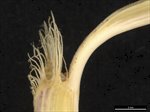
T. secunda orifice with characteristic stiff fimbriae.
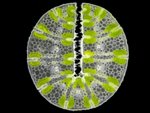
T. secunda leaf section.
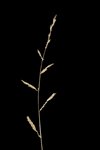
T. secunda inflorescence.
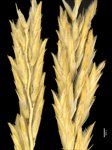
T. secunda inflorescence branch showing difference in appearance from above and below due to the secund (oriented to one side) arrangement of spikelets.

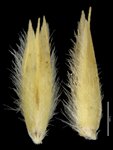
T. secunda lemmas.
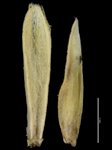
T. secunda paleas.

T. secunda map.
Name
Triodia secunda N.T. Burb.
Citation
J. Roy. Soc. Western Australia 30: 27–28 (1946)
Derivation
secunda —from Latin secundus, in botany indicating organs that are all oriented to the same side, here in reference to spikelet orientation on branches.Common name
Running Buck Spinifex (Burbidge 1946)
Synonyms
None
Diagnostic features
With very long stolons (up to 2 m of bare stem connecting clumps); foliage non-resinous; leaf blades amphistomatous (hard-type) bright to dark green in active growth, the apex especially pungent; leaf sheath surfaces glabrous; orifice glabrous, but with stiff fimbriae; longest basal pedicels 0.5–1.5 mm long; spikelets secund on panicle branches; on broad alluvial flats in the northern Pilbara.
Habitat
Occurs on broad open alluvial flats near large rivers and paleo-rivers, sometimes in saline conditions on the edge of mudflats or saline clay-pans.
Distribution and frequency
Endemic to the north-east Pilbara. Abundant and usually the dominant species in its narrow habitat.
Similar species
Triodia secunda belongs to the Angusta-Wiseana group, by virtue of having amphistomatous (hard-type) leaf blades and 1–3-nerved glumes. Triodia secunda is unique in Triodia in having stiff fimbriae at the orifice (junction of the leaf blade and sheath).
Triodia angusta has similar dense, secund inflorescences and asymmetric glumes to T. secunda but lacks stiff fimbriae at the orifice (diagnostic for T. secunda), has dull green to blue-green foliage (bright to dark green in T. secunda), and stolons, when present, are short (usually very long and conspicuous in T. secunda).
Conservation status
Not considered at risk.
Identification without florets
The unique stiff fimbriae at the junction of the leaf blade and sheath allows instant recognition. The alluvial flat habit, very long stolons (bare stems up to 2 m long between clumps), and usually hairy inflorescences are also distinctive.
Variation
A fairly uniform species.
Notes
The concept of T. secunda is the same as in Lazarides (1997), Lazarides et al. (2005) and Ausgrass (Sharp & Simon, 2002; Simon & Alonso, 2014), which include full descriptions.
Not palatable to stock except under extreme conditions (Burbidge 1946).
Population structure is probably significantly clonal, since interconnected clones cover tens of meters, running on long stolons.